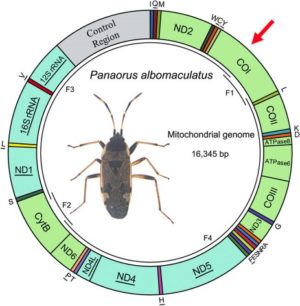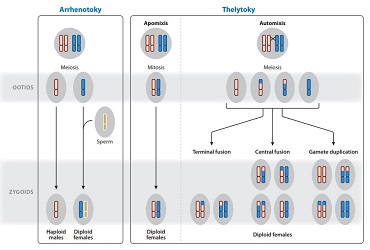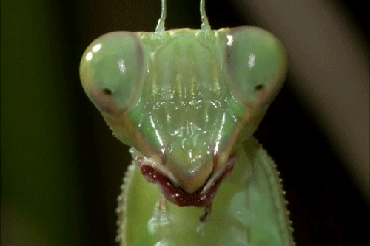By Vincent ALBOUY
Specialization/Generalism
Specialization is defined as physical, biological and/or behavioural adaptation to a small group of partners. Bryona dioica (Bryona dioica), a wild Cucurbitaceae, flowers in spring in hedges and wastelands. Its greenish-white flowers attract various collectors. Among them, a small blackish bee marked with red, andrène de la bryone (Andrena florea), visits only its flowers, despite the mass of other flowering plants in this season. Similarly in the Mediterranean region, the fig tree (Ficus carica) is pollinated only by a small vegetarian wasp (Blastophaga psenes) which lays eggs in its almost closed inflorescences.
Without the fig tree, the wasp cannot survive. But without the wasp, the fig tree cannot reproduce properly. These two species have established obligatory relations between them. On the other hand if the bee of the bryone depends totally on this plant for its survival, with which it thus developed an obligatory relation, the opposite is not true. Bryone visited and pollinated by other insects has only an optional relationship with its andrene.
Generalism, on the other hand, is defined as the faculty, or possibility, of establishing optional relationships with a large number of partners. Among pollinating insects, the honey bee (Apis mellifera) is an excellent example of a generalist bee feeder. It can forage on hundreds of different species of flowers. Native plants or introduced plants, as long as the flower produces nectar or pollen which are accessible to it, it can come to visit them. This generalism has its limits, in particular because of the modest length of its language, five to six millimetres. The narrow flowers where the nectar is found in depth are inaccessible to it.
In plants, generalism translates into the ability to allow many animals to access their nectar or pollen, as in Umbelliferae. On their umbels grouping many small shallow flowers are found most floral insects, beetles, bees, flies, wasps and butterflies. But this all-you-can-eat buffet, by exacerbating competition, drives away the better-off species that prefer other, more profitable sources. The bumble bees or butterflies, equipped with a long tongue or a scrolling trunk are almost never seen on Umbelliferae.
The author : Vincent Albouy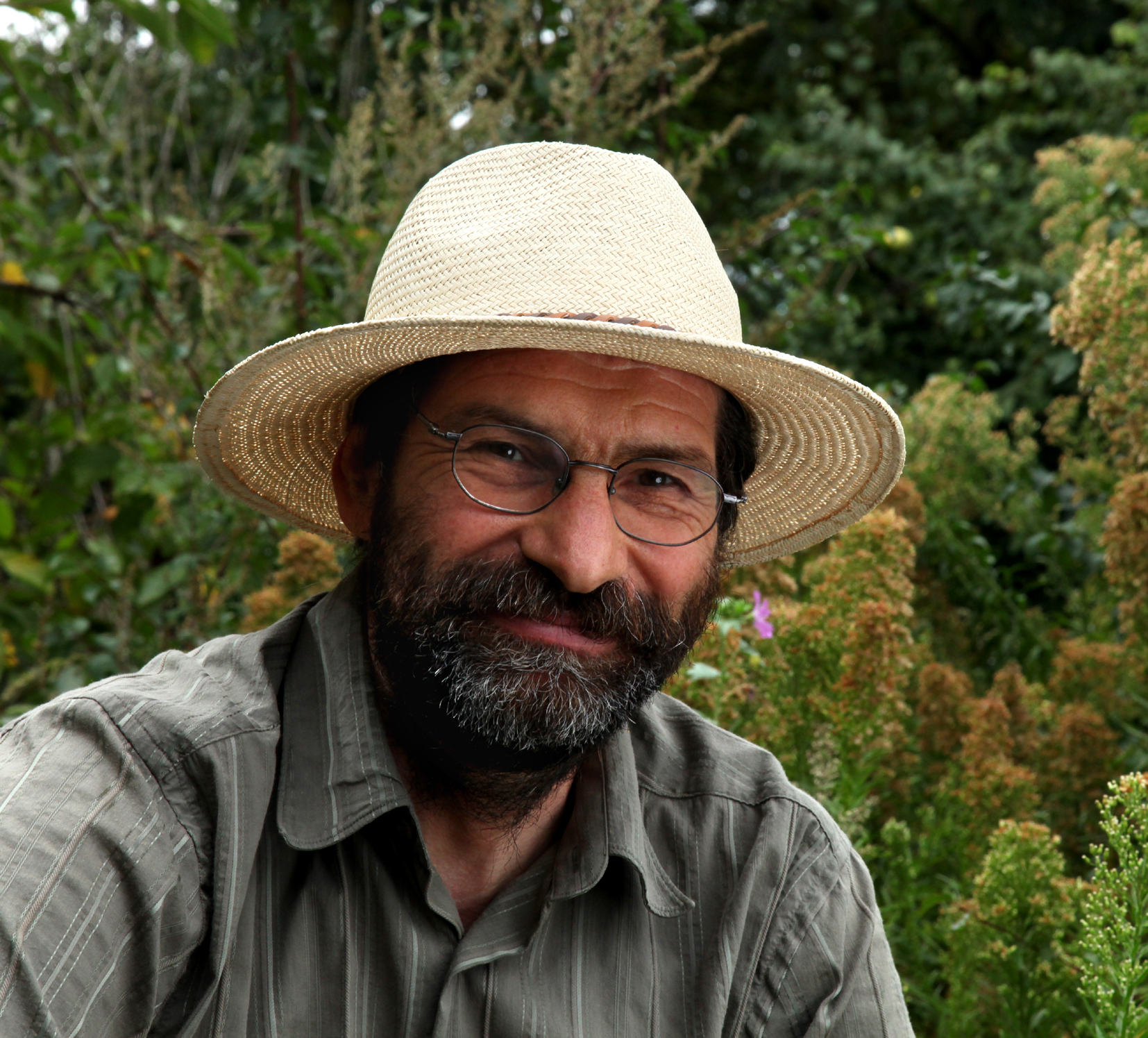 Entomologist by training, Vincent Albouy chaired the Office Pour les Insectes et leur Environnement (OPIE). For thirty years he has been interested in common insects and their protection, ordinary biodiversity and the natural gardening he practices in his garden in Saintonge.
Find the author’s works at the bottom of the page. |
Border disorder
This distinction between specialists and generalists is a formal classification that has reality only in the human mind. It has no concrete translation in nature where all cases are observed in a slow gradation from the broadest generalists to the hyperspecialists linked to a single partner. Moreover the perfect generalist, able to attract all the floral animals or to forage all the flowers does not exist. Some bumblebees are even more generalist than honey bees, but only active during the day they can only visit flowers that open at night. And this generalism remains modest. The terrestrial bumblebee (Bombus terrestris), one of the most generalist, has been noted as foraging on 309 different plant species in our regions, a performance to be compared with the 4,500 species that occur there.
On the other hand, all aspects of the biology of a species must be taken into account. B forageurs who specialise more narrowly in one aspect of their behaviour may be generalists in another. Lysimachus melitte (Macropis europaea), a solitary bee, collects exclusively the pollen necessary for its larvae on the flowers of the common lysimachus (Lysimachia vulgaris). It is thus a hypersspecialist for the pollen because dependent on only one species of plant. But lysimachus does not produce nectar. Then the melitte gathers other flowers for this resource, belonging to families as diverse as those of the daisy, the borage, the rosehip. So she’s a generalist for nectar.
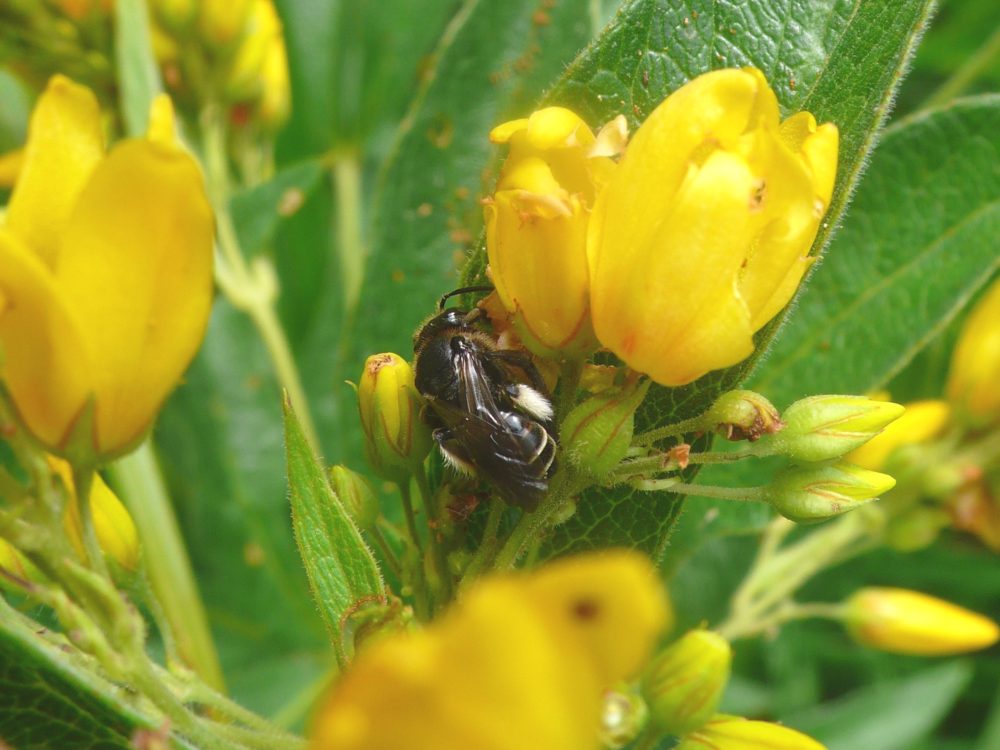
The situation is complicated by finely observing foraging behaviours within the same species. Two individuals may have very different foraging choices. The studies mainly concerned the honey bee, one of the most generalist species as we have seen. The colony makes the best use of the available resources as the analyses of the pollen returned to the hive prove it: trees, shrubs, climbing plants, herbaceous plants, wild or cultivated plants, all the environment within a radius of several kilometers around the hive is explored and exploited.
But the analysis of the behaviour of individuals shows something quite different. The foragers’ careers are short in spring and summer, at the time of the great honeyflies, when flowering and resources abound. Two weeks at the most. And during these two weeks, the great majority of foragers will be satisfied with exploiting only a few species, even only one. This floral consistency is explained by a rationalization of work.
Getting a flower right and quickly requires a little learning, especially for a generalist species that is not preadapted to the flower it visits as can be a specialized species. To pass unceasingly from one type of flowers to the other makes waste time and energy with the forager, thus resources with the colony. Hence the interest of focusing on a single flower, as long as it is available and provides food resources, to save time and make the investment in initial learning profitable.
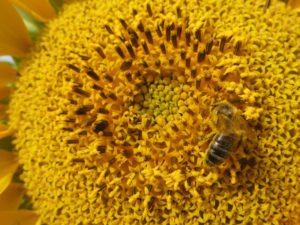
The result is that if the honey bee is a generalist at the species level, it can behave as a specialist at the individual level. How many foragers only know rapeseed flowers or sunflower flowers if they belong to the April or July generations? Only about 5% of female foragers, Girl Scouts who spot interesting new floral resources and inform their sisters about them through a coded dance, really behave in general.
In short, a pollinator can behave as a generalist or specialist depending on the time, the environment, the supply of flowers to forage, the presence or not of other beekeepers competing for certain resources, etc.
Pollination goal
The concept of generalist flowers seems more solid, at least if we judge this generalism by the number of animal pollinators attracted. A tuft of ivy flowers buzzes with an infinity of insects in autumn, flies, butterflies, wasps, bees. His generalism seems indisputable. And yet it is far from obvious if we think in terms of effective pollination.
The only purpose of the flower is to be pollinated, and properly pollinated. So from the point of view of the reproductive success of a plant, we should not judge the number and variety of all visitors, but only those who ensure effective pollination. These effective pollinators may ultimately prove to be few in number.
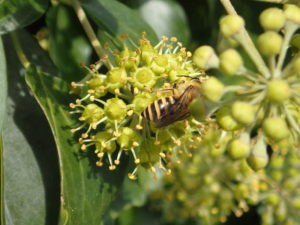
The ivy (Hedera helix) in our regions is mainly pollinated by the honey bee, generalist beekeeper, and by ivy collage (Colletes hederae), a very specialized solitary bee since females only collect larval food on ivy. In northern England, where Colletes hederae is not found, social wasps take over and become effective pollinators. Thus by judging ivy by the yardstick of its effective pollination, it is a species specialized on hymenoptera, and in particular on bees.
Many umbelliferous plants like carrots (Daucus carotta) attract as many insects as ivy, and can be pollinated by most of them : they are true generalist flowers. Hence the concepts of “apparent generalism” (ivy) and “fundamental generalism” (umbelliferae) introduced by scientists. But a detailed analysis of the carrot’s visitors shows that its pollinators belong to a very specific category: small insects with non-specialized mouth parts or short tongues. Some consider it as specialized on this category of floricultural : beetles, flies and wasps mainly.
Pollination Syndrome
The existence of”pollination syndromes” in flowers is an idea widely accepted by botanists. By this expression they mean all the characteristics of a flower adapted to the effective pollinator of the plant, which can be wind, water or animals such as insects, birds, bats.
These character or floral features, concern as well the size, the shape, the type of symmetry of the flower as its color or its smell. When the pollinator is an animal, it mirrors adaptations in its morphology, physiology, and behaviour that betray an co-evolution between the plant and its pollinator, an increasingly close relationship over time and evolution under the pressure of natural selection. Translated into everyday language, this idea implies that there are flowers for bees, butterflies or birds.
- Example of specific co-evolution between two species Colletes cunicularius and Orchidée Ophris occidentalis (The flower mimics the female bee by its shape and smell to attract the male who, in trying to mate with it, will fertilize the flower)
The insects do not see the red, which appears black to them, whereas the birds have the same vision as us. Red is therefore considered characteristic of ornithophilia syndrome. In other words, a red flower is likely to be a flower foraged by birds. The mimulas, the “monkey flowers” of English speakers, found mainly in North America and Australia have given experimental proof of this assertion.
Red flowering species are well visited and pollinated by birds, and pink flowering species are well visited and pollinated by insects. To confirm this adaptation of the flower colour to its pollinator, geneticists manipulated the Lewis mimule (Mimulus lewisii) pink to turn it red, and the cardinal mimule (Mimulus cardinalis) red to turn it pink. This simple colour change resulted in much larger visits of birds on the red insect mimule and of insects on the pink bird mimule.
Some biologists question the reality of pollination syndromes, pointing out that it is impossible to know the effective pollinators of a plant simply by examining its flower. There are too many exceptions to the syndromes rule.
The value of compromise
In parallel with pollination syndromes, pollinator specialisation must also be judged on very broad criteria, for example the possession of a long licking tongue (bumblebees and certain solitary bees) or a sucking trunk (butterflies and certain bombyls). Owners of the same type of tool constitute “functional groups”. Several bollard species capable of performing the same function in a pollinator network constitute a functional group.
- Example of a butterfly Heliconius hecale feeding on nectar on a flower of Psychotria (Panama – B. Gilles)
These groups explain the resilience of pollination networks: if a species disappears, the service is always provided by the other species in its functional group. It is only when an entire functional group disappears that risks of collapse of plant communities become real. The concept is therefore very relevant for understanding the reaction of pollination networks to the disturbances they undergo.
Considered at the species level, pollination syndromes are debated, as we have seen. Considered at the level of functional groups of pollinators, i.e. beekeepers sharing the same major behavioural and morphological characteristics, they appear as a compromise between generalism and specialization.
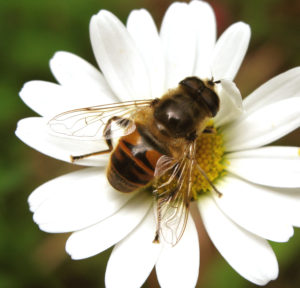
The particular floral features that characterize each syndrome tend towards specialization, to ensure more effective pollination by facilitating the pollinator’s work. But they remain sufficiently generalist to attract a more or less vast set of pollinating species, which guarantees better pollination security in the event of scarcity or disappearance of the most effective pollinators. Spare wheels” are thus ready to be activated. We have seen such a mechanism at work in the case of climbing ivy where a wasp can replace a bee as an effective pollinator.
Generalism and specialisation cannot be judged in themselves but must be assessed in the light of the interactions of the species in question with its environment. These interactions are constantly changing over time or locations, constantly reshuffling the maps. For example, the absence of an effective pollinator may be due to a disturbance of the natural environment, to man or to the small size of the plant population becoming less attractive. The small size of the pollinator community also inevitably modifies these interactions, as in oceanic islands where certain generalist plants on the neighbouring continent become specialists by force of circumstance, whole sections of the normal procession of their pollinators being absent.
The presence of additional plants or animals ultimately causes the same effects. These disturbances are particularly significant when caused by invasive alien species. For example, the invasive plant will offer a large mass of resources to local pollinators, who will turn to it and neglect native plants. Or the invading animal will greatly reduce the population of certain pollinators, such as the varroa or the Asian hornet, which attack honey bees. These parameters may vary between plant communities and over time within each community, but all have an impact on pollination networks and thus on animal pollinated plant populations.
Pollination network
Fieldwork on pollination networks to better understand generalization and specialization comes up against countless interactions that make the analysis of results very difficult.

A Franco-Canadian team (Fontaine et al., 2006 – link) conducted an experimental study of a pollination network by applying the Descartesprinciple that when a problem is too complex to be studied experimentally, it should be divided into several simpler parts. These researchers have therefore reconstituted simplified pollination networks in greenhouses. They formed a community of plants comprising three generalist species (pollen and nectar easily accessible on flat corolla plates) and three specialized species (pollen and nectar difficult to access at the bottom of a corolla tube). The three generalists chosen are matricaria officinale (Matricaria officinalis), bec-de-crue (Erodium cicutarium) and ravenelle (Raphanus raphanistrum), the three specialists mimule (Mimulus guttatus), cultivated alfalfa (Medicago sativa) and trefoil (Lotus corniculatus).
The pollinator community is similarly made up of two groups of three species. The functional group of long-tongue generalists, exceeding 8 mm in length, includes the terrestrial drone (Bombus terrestris), the garden drone (B. hortorum) and the stone drone (B. lapidarius). They can forage both flat flowers and tube flowers. The functional group of short tongue specialists, reaching at most 5 mm, includes the sticky syrphus (Episyrhus balteatus), the sticky eristale (Eristalis tenax) and another syrph, a spherophore (Sphaerophoria sp.). They can only collect flat flowers, nectar and pollen from deep flowers in tube are inaccessible to them. Hoverflies are considered generalist pollinators in nature because there is a large mass of flowers with easily accessible nectar. They only become specialists within the hyper-simplified framework of this study.
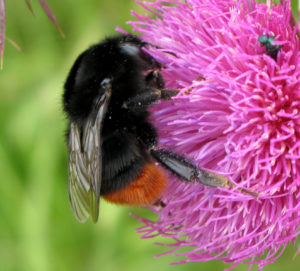


Three kinds of plant community were formed in cubic cages made of nylon voile: only generalist flowers, only specialized flowers, and the two groups together. And each of these communities has received three different pollinator communities: either generalists only, or specialists only, and the two groups together. The study lasted two years, monitoring the number of insect visits to the plants, as well as the reproductive success of the plants based on their fruit and seed production and the number of seedlings growing after these two years.
Communities composed only of generalist flowers, nectar and pollen easily accessible, have experienced the same reproductive success regardless of the pollinator community. Their pollination network is sufficiently varied to support the disappearance of a functional group as a whole.
Communities composed only of specialized flowers, with nectar and pollen hidden at the bottom of a deep tube, have a much higher reproductive success when they are gleaned by long-tongue generalists. When the pollinator community is reduced to the functional group of short language specialists only, this success is much weaker. In the case of these communities, the functional group of long-tongue browsers therefore appears to be a “keystone” group: that it disappears and the community collapses.
A finer analysis shows that generalist flowers, when gleaned only by bumblebees, reproduce a little less well when mixed with specialized flowers than when they are all alone. In the latter case, the bumblebees have no choice and forage them diligently. However, when they have a choice, they prefer deep flowers. In the competition between flat flowers and deep flowers to attract bumblebees, the latter win hands down.
In fact, and this is not a surprise, the reproductive success of plants is greatest when specialists and generalists are mixed both in the plant community and in the pollinator network. In this case, the pollinators share the work: the syrphs concentrate on the flat flowers, and the bumblebees on the tube flowers. In the end, everyone, plants and insects, behaves like a specialist, and this mini-ecosystem then reaches its highest productivity.
Sources
- Albrecht M, Schmid B, Hautier Y & Müller CB (2012) : Diverse pollinator communities enhance plant reproductive success. Procedings of the Royal Society B 279 : 4845–4852 (link)
- Bradshaw Jr HD & Schemske DW (2003) : Allele substitution at a flower colour locus produces a pollinator shift in monkeyflowers. Nature 426 : 176–178 (link)
- Fenster CB, Armbruster WS, Wilson P, Dudash MR & Thomson JD (2004) : Pollination syndromes and floral specialization. Annual Review of Ecology, Evolution, and Systematics 35: 375–403 (link)
- Fontaine C, Dajoz I, Meriguet J & Loreau M (2006) : Functional diversity of plant-pollinator interaction webs enhances the persistence of plant communities. PLoS Biol, 4(1), e1 (link)
- Ollerton J, Alarcón R, Waser NM, Price MV, Watts S, Cranmer L, Hingston A, Peter CI & Rotenberry R (2009) : A global test of the pollination syndrome hypothesis. Annals of Botany 103(9) : 1471–1480 (link)
- Ollerton J, Killick A, Lamborn E, Watts S & Whiston M (2007) : Multiple meanings and modes: on the many ways to be a generalist flower. Taxon 56(3) : 717–728 (link)
- Song Z & Feldman MW (2014) : Adaptive foraging behaviour of individual pollinators and the coexistence of co-flowering plants. Proc. R. Soc. B 281: 20132437 (link)
Ouvrages recommandés sur cette thématique
- Pollinisation : Le génie de la nature
(Vincent Albouy – Editions Quae – 184 pages – 26 avril 2018)
- Sur les traces des petites bêtes
(Vincent Albouy & André Fouquet- Editions Delachaux – 96 pages – 26 avril 2018)
- Jardinez avec les insectes – Comprendre, prévenir, attirer et contrôler les invertébrés au jardin
(Vincent Albouy – Editions Ulmer – 64 pages – 1 février 2018)
- Le Petit guide entomo
(Vincent Albouy ; Claire Felloni ; Gilbert Hodebert & André Fouquet – Editions Delachaux – 216 pages – 1 1 mai 2017)
- Guide des curieux de nature
(Vincent Albouy & Claire Felloni – Editions Delachaux – 224 pages – 12 février 2017)
- Abeilles sauvages. Les connaître, les accueillir (Vincent Albouy – Editions Delachaux – 128 pages – 25 février 2016)
- Guide des petites bêtes des villes et des jardins
(Vincent Albouy – Editions Belin – 224 pages – 15 mars 2013)
- Les auxiliaires au jardin – Une solution alternative aux pesticides
(Vincent Albouy – Terran Editions – 360 pages – 1 novembre 2009)

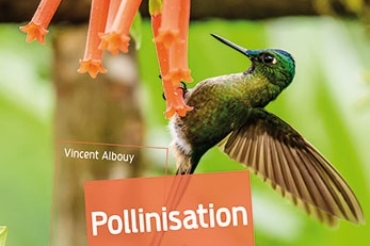
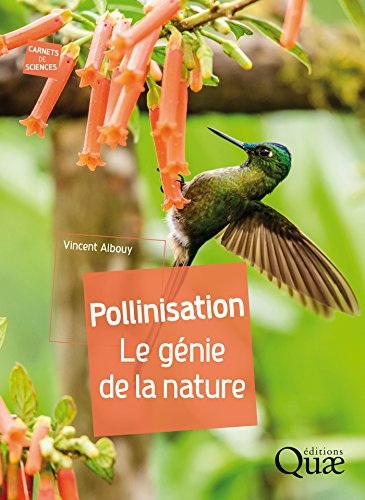 Author of numerous books on nature in general and insects in particular, he has just published ”
Author of numerous books on nature in general and insects in particular, he has just published ” 